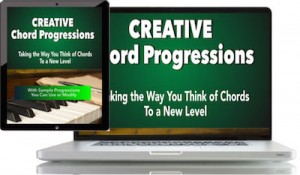Last week I wrote about the similarities between classical and pop music, and what today’s songwriters can learn from the classics. Today I want to look specifically at song melodies, and see to what extent the structure of a pop melody resembles that of a classical work.
There is a book that is in great use in college-level classical music degree programs. “Techniques and Materials of Music“, written by Thomas Benjamin, et al, puts a microscope on how classical music works, but it never ceases to amaze me how applicable many of the observations are to songwriting in the pop genres.
 Do you wish you could take your chord progressions beyond the basic I-IV-V kind, but don’t know how? “Creative Chord Progressions” gives you dozens of suggestions that will breathe fresh air into your songs. Get it free right now with your purchase of the 10-eBook Bundle.
Do you wish you could take your chord progressions beyond the basic I-IV-V kind, but don’t know how? “Creative Chord Progressions” gives you dozens of suggestions that will breathe fresh air into your songs. Get it free right now with your purchase of the 10-eBook Bundle.
Take, for example, these five characteristics of a typical classical melody as outlined in Chapter 18, “An Introduction to Tonal Melody.” The five descriptors might apply to a Beethoven melody (they use Beethoven’s Piano Trio op. 1, No. 3, as an example), but can apply equally well to a song like, say, “Hallelujah” (Leonard Cohen).
I would paraphrase (and hopefully not over-simplify) the five characteristics this way:
- Most melodies use repetition, arpeggiation (i.e., “broken chords”), and stepwise motion (i.e., moving by scale tones).
- The structure of a melody depends on the underlying chords. At the ends of musical lines (phrases), melodies and chords work closely together.
- Most melodies are confined mainly to an octave, with occasional notes higher and/or lower than that main octave.
- With regard to rhythm, faster notes happen on weak beats. Longer notes happen on strong beats. Most melodies will use one or two main rhythmic ideas, with variations happening now and then, especially near the ends of phrases.
- The style of a melody depends on the instruments (including voice) that are performing it, as well as the purpose of the music. (e.g., in pop music terms, a melody’s style will depend on whether the song is a love ballad or a dance tune.)
If you now imagine a modern song from pop or rock (such as “Hallelujah”, as I previously suggested), you’ll see that not much has changed since the days of Beethoven:
- Repetition and stepwise motion in “Hallelujah” is easy to notice, and Cohen uses that repetitive, lulling opening figure (long note-short note) figure over and over, along with repetitions in actual melody notes.
- As in all “tonal” songs (i.e., songs that are in a key), the melody of “Hallelujah” is completely supported by the chord choices.
- “Hallelujah” sits mainly within an octave. In “Techniques and Materials of Music”, the suggestion is that most of the time, the octave is going to be from the tonic note to the octave above, or, less commonly, from the dominant (5th) note to the octave above. With “Hallelujah”, the octave is from the mediant note (i.e., the 3rd note of the key) to the octave above.
- Faster notes happen at the ends of phrases, especially on the word “Hallelujah” itself.
- “Hallelujah” is a ballad, which accounts for the great use of stepwise motion in the melody.
It’s not a good idea to take a perfectly good song that you’ve written, and then try to change it simply because one of the characteristics listed above don’t seem to be present. Even Beethoven composed largely by instinct, not by a set of instructions.
But if you find that your melodies seem lifeless, aimless, or simply dull, it’s worth seeing if one of the five characteristics listed above might be missing.
To familiarize yourself with how closely or not they pertain to your favourite genre, practice your musical observational skills: Make a list of 5 of your favourite songs, and go back to the top of this article and see how much you see those five musical characteristics.
As you get better at analyzing music in this way, you’ll find your own approach to writing melodies improving, and you’ll gain the same advantages classical composers have experienced.
 Written by Gary Ewer. Follow Gary on Twitter
Written by Gary Ewer. Follow Gary on Twitter
 The 10 songwriting eBooks contained in “The Essential Secrets of Songwriting” Deluxe Bundle describe every aspect of songwriting: how to write better melodies, chords, lyrics, and more. Comes with hundreds of progressions for you to use as is, or modify for your own songs. GET TODAY’S SPECIAL DEAL.
The 10 songwriting eBooks contained in “The Essential Secrets of Songwriting” Deluxe Bundle describe every aspect of songwriting: how to write better melodies, chords, lyrics, and more. Comes with hundreds of progressions for you to use as is, or modify for your own songs. GET TODAY’S SPECIAL DEAL.











Pingback: Music : PRandy – Hallelujah (Prod. Gemangel) | @IamPrandy | Gzenter10ment